 |
 |
Our enthusiastic and extremely knowledgeable perennials team is here to answer your questions and help you choose the best perennials for your situation. There’s always something in bloom for sun, shade, butterflies, birds or deer resistance as well as a variety of bulbs for your space.
Stroll through our time-tested favorites and introduce yourself to the newest varieties. We garden with perennials too; we love them and it shows!
|
761 found, showing page 5 of 51
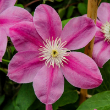
Height: 4 feet
Spread: 12 inches
Sunlight: full sun
Hardiness Zone: 4a
Description:
A striking cultivar which is free flowering both in spring and late summer; large lavender-pink flowers with hot pink stripes and cream centers; a great repeat bloomer, perfect for arbors and containers
Ornamental Features:
Alaina Clematis features showy lavender star-shaped flowers with creamy white eyes and hot pink stripes at the ends of the stems from mid spring to late summer. Its compound leaves remain green in color throughout the season.
Landscape Attributes:
Alaina Clematis is an herbaceous perennial vine with a twining and trailing habit of growth. Its medium texture blends into the garden, but can always be balanced by a couple of finer or coarser plants for an effective composition.
This is a relatively low maintenance plant. It is a Type 2 clematis, which means it will bloom primarily on old wood of the previous season, with a second flush later in summer. Dead and weak vines should be removed in late winter, and remaining vines should be trimmed back to the first buds that are seen to remove dead stems. It is a good choice for attracting hummingbirds to your yard. It has no significant negative characteristics.
Alaina Clematis is recommended for the following landscape applications:
- Accent
- Hedges/Screening
- General Garden Use
- Container Planting
- Planting & Growing
Alaina Clematis will grow to be about 4 feet tall at maturity, with a spread of 12 inches. As a climbing vine, it should either be planted near a fence, trellis or other landscape structure where it can be trained to grow upwards on it, or allowed to trail off a retaining wall or slope. It grows at a medium rate, and under ideal conditions can be expected to live for approximately 20 years. As an herbaceous perennial, this plant will usually die back to the crown each winter, and will regrow from the base each spring. Be careful not to disturb the crown in late winter when it may not be readily seen!
This plant should only be grown in full sunlight. It does best in average to evenly moist conditions, but will not tolerate standing water. It is not particular as to soil type or pH. It is somewhat tolerant of urban pollution. Consider applying a thick mulch around the root zone in both summer and winter to conserve soil moisture and protect it in exposed locations or colder microclimates. This particular variety is an interspecific hybrid.
Alaina Clematis is a fine choice for the garden, but it is also a good selection for planting in outdoor pots and containers. Because of its spreading habit of growth, it is ideally suited for use as a 'spiller' in the 'spiller-thriller-filler' container combination; plant it near the edges where it can spill gracefully over the pot. Note that when growing plants in outdoor containers and baskets, they may require more frequent waterings than they would in the yard or garden.

Height: 6 feet
Spread: 24 inches
Sunlight: full sun
Hardiness Zone: 4a
Description:
A lovely clematis with soft pink flower petals streaked in the center with a deeper pink; inner petals are delicate and hair like; an elegant addition to the garden or container
Ornamental Features:
Empress Clematis features showy shell pink star-shaped flowers with hot pink streaks at the ends of the branches from late spring to late summer. It has green deciduous foliage. The compound leaves do not develop any appreciable fall color.
Landscape Attributes:
Empress Clematis is a multi-stemmed deciduous woody vine with a twining and trailing habit of growth. Its average texture blends into the landscape, but can be balanced by one or two finer or coarser trees or shrubs for an effective composition.
This is a relatively low maintenance woody vine. It is a Type 2 clematis, which means it will bloom primarily on old wood of the previous season, with a second flush later in summer. Dead and weak vines should be removed in late winter, and remaining vines should be trimmed back to the first buds that are seen to remove dead stems. It is a good choice for attracting hummingbirds to your yard. It has no significant negative characteristics.
Empress Clematis is recommended for the following landscape applications:
- Accent
- Hedges/Screening
- General Garden Use
- Container Planting
Planting & Growing:
Empress Clematis will grow to be about 6 feet tall at maturity, with a spread of 24 inches. As a climbing vine, it tends to be leggy near the base and should be underplanted with low-growing facer plants. It should be planted near a fence, trellis or other landscape structure where it can be trained to grow upwards on it, or allowed to trail off a retaining wall or slope. It grows at a medium rate, and under ideal conditions can be expected to live for approximately 20 years.
This woody vine should only be grown in full sunlight. It does best in average to evenly moist conditions, but will not tolerate standing water. It is not particular as to soil type or pH. It is somewhat tolerant of urban pollution. Consider applying a thick mulch around the root zone in both summer and winter to conserve soil moisture and protect it in exposed locations or colder microclimates. This particular variety is an interspecific hybrid.
Empress Clematis makes a fine choice for the outdoor landscape, but it is also well-suited for use in outdoor pots and containers. Because of its spreading habit of growth, it is ideally suited for use as a 'spiller' in the 'spiller-thriller-filler' container combination; plant it near the edges where it can spill gracefully over the pot. It is even sizeable enough that it can be grown alone in a suitable container. Note that when grown in a container, it may not perform exactly as indicated on the tag - this is to be expected. Also note that when growing plants in outdoor containers and baskets, they may require more frequent waterings than they would in the yard or garden.

Height: 5 feet
Spread: 5 feet
Sunlight: full sun
Hardiness Zone: 4a
Description:
A non-climbing variety; beautiful lavender blue star flowers all season; attracts hummingbirds; intermingle with other plants in the garden, or containers; plant in full sun and keep the roots cool for best results
Ornamental Features:
Arabella Clematis features showy lavender star-shaped flowers with blue overtones and white anthers at the ends of the branches from late spring to early fall. It has green deciduous foliage. The compound leaves do not develop any appreciable fall color.
Landscape Attributes:
Arabella Clematis is a multi-stemmed deciduous shrub with a ground-hugging habit of growth. Its average texture blends into the landscape, but can be balanced by one or two finer or coarser trees or shrubs for an effective composition.
This is a relatively low maintenance shrub. It is a Type 3 clematis; each spring it should be pruned back to within a few inches of the ground, as it flowers on new wood of the season. It is a good choice for attracting hummingbirds to your yard. It has no significant negative characteristics.
Arabella Clematis is recommended for the following landscape applications:
- Accent
- General Garden Use
- Container Planting
- Planting & Growing
Arabella Clematis will grow to be about 5 feet tall at maturity, with a spread of 5 feet. It has a low canopy with a typical clearance of 1 foot from the ground, and is suitable for planting under power lines. It grows at a medium rate, and under ideal conditions can be expected to live for approximately 20 years.
This shrub should only be grown in full sunlight. It does best in average to evenly moist conditions, but will not tolerate standing water. It is not particular as to soil type or pH. It is somewhat tolerant of urban pollution. Consider applying a thick mulch around the root zone in both summer and winter to conserve soil moisture and protect it in exposed locations or colder microclimates. This particular variety is an interspecific hybrid.
Arabella Clematis makes a fine choice for the outdoor landscape, but it is also well-suited for use in outdoor pots and containers. Because of its spreading habit of growth, it is ideally suited for use as a 'spiller' in the 'spiller-thriller-filler' container combination; plant it near the edges where it can spill gracefully over the pot. It is even sizeable enough that it can be grown alone in a suitable container. Note that when grown in a container, it may not perform exactly as indicated on the tag - this is to be expected. Also note that when growing plants in outdoor containers and baskets, they may require more frequent waterings than they would in the yard or garden.
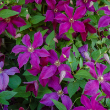
Height: 10 feet
Spread: 24 inches
Sunlight: full sun
Hardiness Zone: 3a
Description:
A vigorous, hardy and very showy vine featuring an abundance of rich purple flowers throughout the summer and into fall, doesn't know when to stop blooming; nearly indestructible
Ornamental Features:
Polish Spirit Clematis features showy purple star-shaped flowers at the ends of the branches from mid summer to early fall. It has green deciduous foliage. The compound leaves do not develop any appreciable fall color.
Landscape Attributes:
Polish Spirit Clematis is a multi-stemmed deciduous woody vine with a twining and trailing habit of growth. Its average texture blends into the landscape, but can be balanced by one or two finer or coarser trees or shrubs for an effective composition.
This is a relatively low maintenance woody vine. It is a Type 3 clematis; each spring it should be pruned back to within a few inches of the ground, as it flowers on new wood of the season. It is a good choice for attracting hummingbirds to your yard. It has no significant negative characteristics.
Polish Spirit Clematis is recommended for the following landscape applications:
- Accent
- Hedges/Screening
- General Garden Use
- Container Planting
Planting & Growing:
Polish Spirit Clematis will grow to be about 10 feet tall at maturity, with a spread of 24 inches. As a climbing vine, it tends to be leggy near the base and should be underplanted with low-growing facer plants. It should be planted near a fence, trellis or other landscape structure where it can be trained to grow upwards on it, or allowed to trail off a retaining wall or slope. It grows at a medium rate, and under ideal conditions can be expected to live for approximately 20 years.
This woody vine should only be grown in full sunlight. It does best in average to evenly moist conditions, but will not tolerate standing water. It is not particular as to soil type or pH. It is somewhat tolerant of urban pollution. Consider applying a thick mulch around the root zone in both summer and winter to conserve soil moisture and protect it in exposed locations or colder microclimates. This particular variety is an interspecific hybrid.
Polish Spirit Clematis makes a fine choice for the outdoor landscape, but it is also well-suited for use in outdoor pots and containers. Because of its spreading habit of growth, it is ideally suited for use as a 'spiller' in the 'spiller-thriller-filler' container combination; plant it near the edges where it can spill gracefully over the pot. It is even sizeable enough that it can be grown alone in a suitable container. Note that when grown in a container, it may not perform exactly as indicated on the tag - this is to be expected. Also note that when growing plants in outdoor containers and baskets, they may require more frequent waterings than they would in the yard or garden.

CLEMATIS 'SAMARITAN JO' 1G

Long blooming deep reddish purple flowers from late spring to early fall. Compact. USDA 5-9

CLEMATIS 'AVANT GARDE' 1G
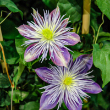
Height: 10 feet
Spread: 24 inches
Sunlight: full sun, partial shade
Hardiness Zone: 4a
Group/Class: Early large-flowered
Description:
Spectacular large, early double lavender-blue flowers with some violet undertones and white, spiky centres, are produced on a vigorous vine, a great plant for the novice and expert gardener alike
Ornamental Features:
Crystal Fountain Clematis features showy lavender star-shaped flowers with violet overtones and white centers at the ends of the branches from late spring to early fall. It has green deciduous foliage. The compound leaves do not develop any appreciable fall color.
Landscape Attributes:
Crystal Fountain Clematis is a multi-stemmed deciduous woody vine with a twining and trailing habit of growth. Its average texture blends into the landscape, but can be balanced by one or two finer or coarser trees or shrubs for an effective composition.
This is a relatively low maintenance woody vine. It is a Type 2 clematis, which means it will bloom primarily on old wood of the previous season, with a second flush later in summer. Dead and weak vines should be removed in late winter, and remaining vines should be trimmed back to the first buds that are seen to remove dead stems. It is a good choice for attracting bees and hummingbirds to your yard. It has no significant negative characteristics.
Crystal Fountain Clematis is recommended for the following landscape applications
- Accent
- Hedges/Screening
- General Garden Use
- Container Planting
- Planting & Growing
Crystal Fountain Clematis will grow to be about 10 feet tall at maturity, with a spread of 24 inches. As a climbing vine, it tends to be leggy near the base and should be underplanted with low-growing facer plants. It should be planted near a fence, trellis or other landscape structure where it can be trained to grow upwards on it, or allowed to trail off a retaining wall or slope. It grows at a medium rate, and under ideal conditions can be expected to live for approximately 20 years.
This woody vine does best in full sun to partial shade. It does best in average to evenly moist conditions, but will not tolerate standing water. It is not particular as to soil type or pH. It is somewhat tolerant of urban pollution. Consider applying a thick mulch around the root zone in both summer and winter to conserve soil moisture and protect it in exposed locations or colder microclimates. This particular variety is an interspecific hybrid.
Crystal Fountain Clematis makes a fine choice for the outdoor landscape, but it is also well-suited for use in outdoor pots and containers. Because of its spreading habit of growth, it is ideally suited for use as a 'spiller' in the 'spiller-thriller-filler' container combination; plant it near the edges where it can spill gracefully over the pot. It is even sizeable enough that it can be grown alone in a suitable container. Note that when grown in a container, it may not perform exactly as indicated on the tag - this is to be expected. Also note that when growing plants in outdoor containers and baskets, they may require more frequent waterings than they would in the yard or garden.

Height: 10 feet
Spread: 24 inches
Sunlight: full sun
Hardiness Zone: 4a
Description:
An early-blooming variety of this choice flowering vine featuring large pure white flowers with a distinctive and prominent chocolate-purple center, extremely showy in the early summer garden; may rebloom in fall
Ornamental Features:
Miss Bateman Clematis features showy white star-shaped flowers with deep purple anthers at the ends of the branches in early summer. It has green deciduous foliage. The compound leaves do not develop any appreciable fall color.
Landscape Attributes:
Miss Bateman Clematis is a multi-stemmed deciduous woody vine with a twining and trailing habit of growth. Its average texture blends into the landscape, but can be balanced by one or two finer or coarser trees or shrubs for an effective composition.
This is a relatively low maintenance woody vine. It is a Type 1 clematis, meaning that it flowers on old wood of the previous season; other than trimming off obvious dieback in spring, it should only be pruned where necessary immediately after flowering. It is a good choice for attracting hummingbirds to your yard. It has no significant negative characteristics.
Miss Bateman Clematis is recommended for the following landscape applications:
- Accent
- Hedges/Screening
- General Garden Use
- Container Planting
Planting & Growing:
Miss Bateman Clematis will grow to be about 10 feet tall at maturity, with a spread of 24 inches. As a climbing vine, it tends to be leggy near the base and should be underplanted with low-growing facer plants. It should be planted near a fence, trellis or other landscape structure where it can be trained to grow upwards on it, or allowed to trail off a retaining wall or slope. It grows at a medium rate, and under ideal conditions can be expected to live for approximately 20 years.
This woody vine should only be grown in full sunlight. It does best in average to evenly moist conditions, but will not tolerate standing water. It is not particular as to soil type or pH. It is somewhat tolerant of urban pollution. Consider applying a thick mulch around the root zone in both summer and winter to conserve soil moisture and protect it in exposed locations or colder microclimates. This particular variety is an interspecific hybrid.
Miss Bateman Clematis makes a fine choice for the outdoor landscape, but it is also well-suited for use in outdoor pots and containers. Because of its spreading habit of growth, it is ideally suited for use as a 'spiller' in the 'spiller-thriller-filler' container combination; plant it near the edges where it can spill gracefully over the pot. It is even sizeable enough that it can be grown alone in a suitable container. Note that when grown in a container, it may not perform exactly as indicated on the tag - this is to be expected. Also note that when growing plants in outdoor containers and baskets, they may require more frequent waterings than they would in the yard or garden.
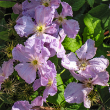
Height: 10 feet
Spread: 24 inches
Sunlight: full sun, partial shade
Hardiness Zone: 4a
Other Names: Blekitny Aniol Clematis
Description:
Silky sky-blue flowers with lighter central bars and pretty ruffled edges; petals contrast nicely with yellow stamens; this vine attracts hummingbirds and makes a fabulous screen; plant in full sun and keep the roots cool for best results
Ornamental Features:
Blue Angel Clematis is covered in stunning sky blue star-shaped flowers with white overtones and yellow anthers at the ends of the branches from mid summer to early fall. It has green deciduous foliage. The compound leaves do not develop any appreciable fall color.
Landscape Attributes:
Blue Angel Clematis is a multi-stemmed deciduous woody vine with a twining and trailing habit of growth. Its average texture blends into the landscape, but can be balanced by one or two finer or coarser trees or shrubs for an effective composition.
This is a relatively low maintenance woody vine. It is a Type 3 clematis; each spring it should be pruned back to within a few inches of the ground, as it flowers on new wood of the season. It is a good choice for attracting hummingbirds to your yard. It has no significant negative characteristics.
Blue Angel Clematis is recommended for the following landscape applications:
- Accent
- Hedges/Screening
- General Garden Use
- Container Planting
Planting & Growing:
Blue Angel Clematis will grow to be about 10 feet tall at maturity, with a spread of 24 inches. As a climbing vine, it tends to be leggy near the base and should be underplanted with low-growing facer plants. It should be planted near a fence, trellis or other landscape structure where it can be trained to grow upwards on it, or allowed to trail off a retaining wall or slope. It grows at a medium rate, and under ideal conditions can be expected to live for approximately 20 years.
This woody vine does best in full sun to partial shade. It does best in average to evenly moist conditions, but will not tolerate standing water. It is not particular as to soil type or pH. It is somewhat tolerant of urban pollution. Consider applying a thick mulch around the root zone in both summer and winter to conserve soil moisture and protect it in exposed locations or colder microclimates. This particular variety is an interspecific hybrid.
Blue Angel Clematis makes a fine choice for the outdoor landscape, but it is also well-suited for use in outdoor pots and containers. Because of its spreading habit of growth, it is ideally suited for use as a 'spiller' in the 'spiller-thriller-filler' container combination; plant it near the edges where it can spill gracefully over the pot. It is even sizeable enough that it can be grown alone in a suitable container. Note that when grown in a container, it may not perform exactly as indicated on the tag - this is to be expected. Also note that when growing plants in outdoor containers and baskets, they may require more frequent waterings than they would in the yard or garden.
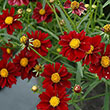
Height: 18 inches
Spread: 30 inches
Sunlight: full sun
Hardiness Zone: 4b
Description:
An impressive hybrid with stunning, daisy-like burgundy-violet flowers with scarlet petal edges, around a central yellow-gold disk; a vigorous grower, that is tolerant of pests and drought, thriving in sandy and rocky soils; coreopsis needs good drainage
Ornamental Features:
Mercury Rising Tickseed is smothered in stunning burgundy daisy flowers with violet overtones, yellow eyes and scarlet edges at the ends of the stems from early summer to early fall. The flowers are excellent for cutting. Its ferny leaves remain emerald green in color throughout the season.
Landscape Attributes:
Mercury Rising Tickseed is an open herbaceous perennial with a mounded form. It brings an extremely fine and delicate texture to the garden composition and should be used to full effect.
This is a relatively low maintenance plant, and is best cleaned up in early spring before it resumes active growth for the season. It is a good choice for attracting butterflies to your yard, but is not particularly attractive to deer who tend to leave it alone in favor of tastier treats. It has no significant negative characteristics.
Mercury Rising Tickseed is recommended for the following landscape applications:
- Mass Planting
- Border Edging
- General Garden Use
Container Planting
Planting & Growing:
Mercury Rising Tickseed will grow to be about 16 inches tall at maturity, with a spread of 30 inches. Its foliage tends to remain dense right to the ground, not requiring facer plants in front. It grows at a medium rate, and under ideal conditions can be expected to live for approximately 10 years. As an herbaceous perennial, this plant will usually die back to the crown each winter, and will regrow from the base each spring. Be careful not to disturb the crown in late winter when it may not be readily seen!
This plant should only be grown in full sunlight. It does best in average to evenly moist conditions, but will not tolerate standing water. It is not particular as to soil pH, but grows best in poor soils. It is somewhat tolerant of urban pollution. This particular variety is an interspecific hybrid. It can be propagated by division; however, as a cultivated variety, be aware that it may be subject to certain restrictions or prohibitions on propagation.
Mercury Rising Tickseed is a fine choice for the garden, but it is also a good selection for planting in outdoor pots and containers. It is often used as a 'filler' in the 'spiller-thriller-filler' container combination, providing a mass of flowers against which the thriller plants stand out. Note that when growing plants in outdoor containers and baskets, they may require more frequent waterings than they would in the yard or garden.
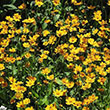
Height: 8 inches
Spread: 10 inches
Sunlight: full sun
Hardiness Zone: 4a
Other Names: Mouse Ear Tickseed
Description:
Dwarf, compact plant with cheery, daisy-like yellow flowers with a prominent central gold disk; tolerant of pests and drier soils; thriving in sandy and rocky soils
Ornamental Features:
Dwarf Tickseed is smothered in stunning yellow daisy flowers at the ends of the stems from mid spring to mid summer. The flowers are excellent for cutting. Its ferny leaves remain emerald green in color throughout the season.
Landscape Attributes:
Dwarf Tickseed is an open herbaceous perennial with a mounded form. It brings an extremely fine and delicate texture to the garden composition and should be used to full effect.
This is a relatively low maintenance plant, and is best cleaned up in early spring before it resumes active growth for the season. It is a good choice for attracting butterflies to your yard, but is not particularly attractive to deer who tend to leave it alone in favor of tastier treats. It has no significant negative characteristics.
Dwarf Tickseed is recommended for the following landscape applications:
- Mass Planting
- Rock/Alpine Gardens
- Border Edging
- General Garden Use
- Groundcover
- Container Planting
Planting & Growing:
Dwarf Tickseed will grow to be about 8 inches tall at maturity, with a spread of 10 inches. Its foliage tends to remain low and dense right to the ground. It grows at a medium rate, and under ideal conditions can be expected to live for approximately 10 years. As an herbaceous perennial, this plant will usually die back to the crown each winter, and will regrow from the base each spring. Be careful not to disturb the crown in late winter when it may not be readily seen!
This plant should only be grown in full sunlight. It does best in average to evenly moist conditions, but will not tolerate standing water. It is not particular as to soil pH, but grows best in poor soils. It is somewhat tolerant of urban pollution. This is a selection of a native North American species. It can be propagated by division; however, as a cultivated variety, be aware that it may be subject to certain restrictions or prohibitions on propagation.
Dwarf Tickseed is a fine choice for the garden, but it is also a good selection for planting in outdoor pots and containers. It is often used as a 'filler' in the 'spiller-thriller-filler' container combination, providing a mass of flowers against which the thriller plants stand out. Note that when growing plants in outdoor containers and baskets, they may require more frequent waterings than they would in the yard or garden.
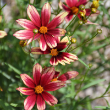
Height: 10 inches
Spread: 15 inches
Sunlight: full sun
Hardiness Zone: 4b
Group/Class: Lil' Bang Series
Brand: Walters Gardens
Description:
A compact variety with stunning, daisy-like, burgundy-red flowers with golden centers; petal tips become frosted with white in midsummer heat; tolerant of pests and drier soils; thriving in sandy and rocky soils; needs good drainage
Ornamental Features:
Lil' Bang Red Elf Tickseed is smothered in stunning burgundy daisy flowers with red overtones and gold eyes at the ends of the stems from early summer to early fall. The flowers are excellent for cutting. Its narrow leaves remain emerald green in color throughout the season.
Landscape Attributes:
Lil' Bang Red Elf Tickseed is an open herbaceous perennial with a mounded form. It brings an extremely fine and delicate texture to the garden composition and should be used to full effect.
This is a relatively low maintenance plant, and is best cleaned up in early spring before it resumes active growth for the season. It is a good choice for attracting butterflies to your yard, but is not particularly attractive to deer who tend to leave it alone in favor of tastier treats. It has no significant negative characteristics.
Lil' Bang Red Elf Tickseed is recommended for the following landscape applications:
- Mass Planting
- Border Edging
- General Garden Use
- Container Planting
Planting & Growing:
Lil' Bang Red Elf Tickseed will grow to be about 8 inches tall at maturity, with a spread of 15 inches. Its foliage tends to remain low and dense right to the ground. It grows at a medium rate, and under ideal conditions can be expected to live for approximately 10 years. As an herbaceous perennial, this plant will usually die back to the crown each winter, and will regrow from the base each spring. Be careful not to disturb the crown in late winter when it may not be readily seen!
This plant should only be grown in full sunlight. It does best in average to evenly moist conditions, but will not tolerate standing water. It is not particular as to soil pH, but grows best in poor soils. It is somewhat tolerant of urban pollution. This particular variety is an interspecific hybrid. It can be propagated by division; however, as a cultivated variety, be aware that it may be subject to certain restrictions or prohibitions on propagation.
Lil' Bang Red Elf Tickseed is a fine choice for the garden, but it is also a good selection for planting in outdoor pots and containers. It is often used as a 'filler' in the 'spiller-thriller-filler' container combination, providing a mass of flowers against which the thriller plants stand out. Note that when growing plants in outdoor containers and baskets, they may require more frequent waterings than they would in the yard or garden.
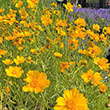
Height: 18 inches
Spread: 24 inches
Sunlight: full sun
Hardiness Zone: 4a
Description:
All this variety needs is well drained soil and lots of sunshine and it will bloom profusely all summer long; a more open and airy form and a wildflower look that blends well in a cottage style garden; when positioning remember flowers follow the sun
Ornamental Features:
Lanceleaf Tickseed is smothered in stunning yellow daisy flowers with gold eyes at the ends of the stems from early summer to early fall. The flowers are excellent for cutting. Its narrow leaves remain green in color throughout the season.
Landscape Attributes:
Lanceleaf Tickseed is an herbaceous perennial with a mounded form. It brings an extremely fine and delicate texture to the garden composition and should be used to full effect.
This is a relatively low maintenance plant, and is best cleaned up in early spring before it resumes active growth for the season. It is a good choice for attracting butterflies to your yard, but is not particularly attractive to deer who tend to leave it alone in favor of tastier treats. It has no significant negative characteristics.
Lanceleaf Tickseed is recommended for the following landscape applications:
- Mass Planting
- Border Edging
- General Garden Use
- Container Planting
Planting & Growing:
Lanceleaf Tickseed will grow to be about 18 inches tall at maturity, with a spread of 24 inches. Its foliage tends to remain dense right to the ground, not requiring facer plants in front. It grows at a medium rate, and under ideal conditions can be expected to live for approximately 10 years. As an herbaceous perennial, this plant will usually die back to the crown each winter, and will regrow from the base each spring. Be careful not to disturb the crown in late winter when it may not be readily seen!
This plant should only be grown in full sunlight. It does best in average to evenly moist conditions, but will not tolerate standing water. It is not particular as to soil pH, but grows best in poor soils. It is somewhat tolerant of urban pollution. This species is native to parts of North America. It can be propagated by division.
Lanceleaf Tickseed is a fine choice for the garden, but it is also a good selection for planting in outdoor pots and containers. It is often used as a 'filler' in the 'spiller-thriller-filler' container combination, providing a mass of flowers against which the thriller plants stand out. Note that when growing plants in outdoor containers and baskets, they may require more frequent waterings than they would in the yard or garden.
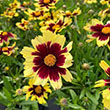
COREOPSIS 'SUPER STAR' 1G
761 found, showing page 5 of 51













